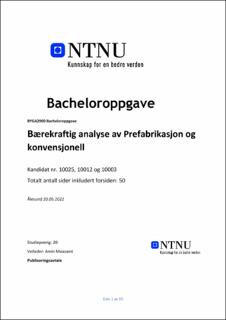| dc.contributor.advisor | Moazami, Amin | |
| dc.contributor.author | Samadi, Ismail. | |
| dc.contributor.author | Venås, Hans Ove | |
| dc.contributor.author | Suliman, Suliman | |
| dc.date.accessioned | 2022-07-07T17:20:13Z | |
| dc.date.available | 2022-07-07T17:20:13Z | |
| dc.date.issued | 2022 | |
| dc.identifier | no.ntnu:inspera:112300464:112301125 | |
| dc.identifier.uri | https://hdl.handle.net/11250/3003618 | |
| dc.description.abstract | Kaihuset oppgaven handler om, ligger i Hellesylt - Stranda kommune. Denne oppgaven skal
ta for seg bærekraftig analyse av plassbygde vegger og prefabrikkerte halmmoduler, med
hensyn på klimaavtrykk. Oppgaven har som hensikt å sammenligne de metodene og avveie
Co2 utslipp av de to metodene. Hovedfokuset vil da være å gjøre en livssyklusanalyse.
Teorien er hentet fra litteraturstudie, Sintef Byggforsk, universitets biblioteker fra USA og
Sverige. I tillegg er det brukt skolebøker og kompendier. Beregning CO2 utslipp av
prefabrikkerte og konvensjonelle vegger er gjort ved bruk av OneClick LCA.
Deretter har løsningen blitt modellert i Revit. Gjennom modellen får man ut mengder
materialene som kan eksporteres til verktøyet for livssyklusanalyse, One Click LCA. Det er
tatt hensyn til produksjon og transport av materialene, riving og avfallsbehandling ved
livsløpets slutt.
Ut ifra resultatene demonstreres da at den bærekraftige bygget har 15.2% lavere utslipp
sammenlignet med det konvensjonelle bygget. Dette er positivt resultat tilsvarende
innenfor den rekkevidden som var antatt. Konvensjonelle veggen danner 3.31 ganger så
mye utslipp sammenlignet med den bærekraftige veggen, dette var mer enn forventet. | |
| dc.description.abstract | Kaihuset the task is about is in Hellesylt, Stranda municipality. This task will address
sustainable analysis of conventional walls and prefabricated straw modules, considering
climate footprints. The task aims to compare the methods and weigh CO2 worn out by the
two. The focus will then be to do a life cycle analysis for the two methods. In addition, the
task deals with the dimensioning of the new solution in prefabricated ecococon wall
elements.
The theory is taken from literature study, Sintef Byggforsk, university libraries from the USA
and Sweden. In addition, schoolbooks and compendiums are used. Calculation of
prefabricated straw modules and conventional ones is done using OneClick LCA.
Then the solution has been modeled in Revit. The model extracts quantities of the various
materials that can be exported to the lifecycle analysis tool, One Click LCA. Consideration
has been given to the production and transport of the materials, demolition and waste
treatment at the end of the life cycle.
Based on the results, it is demonstrated that the sustainable building has 15.2% lower emissions
compared to the conventional building as a whole. This is a positive result corresponding to the
range assumed. Conventional wall forms 3.31 times as many emissions compared to the sustainable
wall, this was more than expected | |
| dc.language | nob | |
| dc.publisher | NTNU | |
| dc.title | Bærekraftig analyse av Prefabrikasjon og
konvensjonell | |
| dc.type | Bachelor thesis | |
